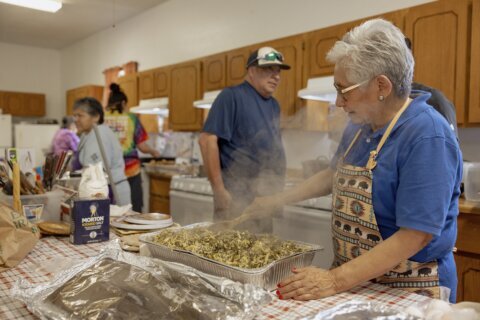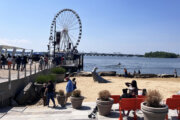TOKYO (AP) — Tokyo’s fish market on Thursday opened a long-awaited outer section with Japanese-style seafood restaurants and a spa for relaxation, as the wholesale venue that has struggled since relocating from the beloved Tsukiji market seeks to lure more visitors.
Toyosu Senkyaku Banrai includes a food court resembling an Edo samurai-era street, lined with about 65 restaurants serving mostly fresh catch from the market next door. Together with visitors at the spa and hotel in another area, the Tokyo metropolitan government that operates the market hopes to attract some 2.6 million visitors annually.
“I’m confident that Tokyo residents and visitors from in and outside Japan will enjoy our diverse food culture as they savor fresh and high-quality food that only the fish market next door can serve,” Tokyo Gov. Yuriko Koike said in a speech at an opening ceremony held before the official launch for visitors.
“I hope the inside and the outside together will further energize this neighborhood,” she added.
Visitors flooded in as soon as the doors opened on Thursday, many of them taking photos of the Edo-style restaurants and stalls, while others lined up outside stalls selling tuna sashimi on sticks and other seafood, or having early lunch at an eel restaurant.
Originally planned to open in 2019 before the Tokyo Olympics and along with the fish market’s relocation from Tsukiji, Toyosu’s outer section is about four years behind schedule due to planning delays and the coronavirus pandemic, officials said. The fish market’s relocation from Tsukiji, initially slated for 2016, was also postponed after the detection of toxic chemicals in the groundwater at the new site, which was formerly a gas plant.
The new Toyosu market offers modern technology and an improved environment for workers, and performs careful safety screenings on fish, including those from Fukushima, but it lacks the open-air, bustling atmosphere that Tsukiji used to have.
Toyosu is also less accessible from downtown Tokyo compared to Tsukiji, which is within walking distance of Ginza and whose outer market stalls and restaurants during lunchtime used to cater to people working in the area and tourists from around the world.
Toyosu saw the amount of seafood it handled drop to 310,000 tons in 2023 from about 400,000 tons before the relocation, in part because of dwindling catches and a growing move by retailers and restaurants to buy directly from suppliers.
Market officials and experts expect Toyosu Senkyaku Banrai (which means “thousands of customers, bustling business”) to continue to attract more visitors, especially from abroad. Some wholesalers recently invented new menus seeking to create further appeal.
Yasuhiro Yamazaki, president of the intermediate wholesale store Yamaharu, said the food street next to the market will add a lively atmosphere and that he hopes that its launch, along with the arrival of more visitors, will create “a synergistic effect.”
Kyoko Fukuchi, an expert on the fish market and its history, said she already knows what she is going to order when she visits the food area: not sushi, but a tuna burger using fish from the market.
___
AP video journalist Chisato Tanaka contributed to this report.
Copyright © 2024 The Associated Press. All rights reserved. This material may not be published, broadcast, written or redistributed.







